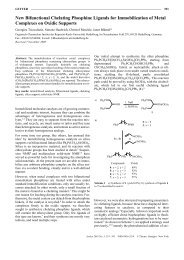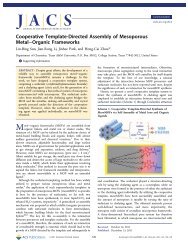Gold Nanoparticles - Department of Chemistry
Gold Nanoparticles - Department of Chemistry
Gold Nanoparticles - Department of Chemistry
Create successful ePaper yourself
Turn your PDF publications into a flip-book with our unique Google optimized e-Paper software.
Nano Letters PERSPECTIVE<br />
Table 2. Examples <strong>of</strong> the Use <strong>of</strong> <strong>Gold</strong> <strong>Nanoparticles</strong> in Clinical Practice<br />
dramatically and linearly increases, with 14 nm nanoparticles<br />
leaving cells twice as fast compared to particles <strong>of</strong> 100 nm size. 71<br />
Furthermore the fraction <strong>of</strong> gold nanorods exocytosed was<br />
higher than spherical-shaped nanostructures. Studies by Pan<br />
and colleagues have also shown that the cytotoxicity <strong>of</strong> gold<br />
nanoparticles primarily depends on their size, with particles<br />
1 2 nm in diameter being toxic whereas larger 15 nm gold<br />
particles are comparatively nontoxic, irrespective <strong>of</strong> the cell type<br />
tested. 74 Furthermore, particles <strong>of</strong> 1.4 nm were found to be<br />
highly toxic as they irreversibly bind to the major grooves <strong>of</strong><br />
B-DNA, an effect not observed with larger or smaller particles<br />
due to steric reasons. Although there are only a limited number <strong>of</strong><br />
in vivo studies investigating the systemic effects <strong>of</strong> gold nanoparticles,<br />
13 nm PEG-coated gold nanoparticles have been<br />
shown to have long circulating times, eventually accumulating<br />
in the liver where they can induce acute inflammation and<br />
apoptosis. 75 The surface charge <strong>of</strong> gold nanoparticles has also<br />
been shown to be important in determining particle toxicity, with<br />
cationic gold nanoparticles exhibiting moderate toxicity owing to<br />
the electrostatic binding <strong>of</strong> the particles to the negatively charged<br />
cell membrane. In contrast, anionic particles have no toxicity as<br />
they are repelled from the membrane. 76<br />
Taken together, the size, shape, and surface charge <strong>of</strong> gold<br />
nanoparticles need to be carefully considered when designing<br />
gold nanoparticles for human use in order to optimize their<br />
therapeutic function, while concurrently decreasing their toxicity<br />
pr<strong>of</strong>ile by minimizing their cellular uptake and interactions. One<br />
way to reduce any potential toxicity from gold nanoparticles is by<br />
the addition <strong>of</strong> surface poly(ethylene glycol) (PEG). PEG is a<br />
coiled polymer <strong>of</strong> repeating ethylene ether units with dynamic<br />
conformations which are inexpensive, versatile, and FDA<br />
approved. 77 In both drug delivery and imaging applications,<br />
the addition <strong>of</strong> PEG to nanoparticles reduces uptake by the<br />
reticuloendothelial system and increases circulation time versus<br />
uncoated counterparts. 78 Recent studies have also shown that<br />
PEGylated nanoparticles generally have lower accumulation<br />
in the liver compared to non-PEGylated nanoparticles and higher<br />
tumor accumulation versus background. 79 Aggregation <strong>of</strong> nanoparticles<br />
also decrease following the addition <strong>of</strong> PEG due to<br />
passivation <strong>of</strong> the nanoparticle surface and the reduction in<br />
the coating <strong>of</strong> serum and tissue proteins, resulting in so-called<br />
“stealth” behavior. PEG also increases the solubility <strong>of</strong> nanoparticles<br />
in buffer and serum due to the hydrophilic ethylene glycol<br />
repeats and the enhanced permeability and retention (EPR)<br />
effect. 80,81 Alternative passivating polymers which can be added<br />
to gold nanoparticles besides PEG include chitosan, dextran,<br />
poly(vinylpyrrolidone) (PVP) as well as the copolymer polylacticcoglycolic<br />
acid (PLGA).<br />
Clinical Use <strong>of</strong> <strong>Gold</strong> <strong>Nanoparticles</strong>. Over the past few years,<br />
gold nanoparticles have been used effectively in laboratory based<br />
clinical diagnostic methodologies (Table 2). In particular, DNAfunctionalized<br />
gold nanoparticles can detect specific DNA and<br />
RNA sequences by rapidly binding to nucleotide sequences<br />
within a sample with high sensitivity. 82 Furthermore, arrays using<br />
gold nanoparticles with specific chemical functionalities are<br />
currently being developed for biomarker platforms to detect,<br />
identify, and quantify protein targets used for clinical<br />
diagnosis. 58,83 However, the main excitement concerning gold<br />
nanoparticles is their potential to cross over into clinical practice<br />
for use in humans.<br />
From an imaging perspective, gold nanoparticles have shown<br />
great promise for their use in computed tomography, Raman<br />
spectroscopy, and photoacoustic imaging. Raman spectroscopy<br />
is an optically based technique which allows the molecular<br />
interrogation <strong>of</strong> tissues based on the inelastic scattering <strong>of</strong><br />
light. 84 However, to date this imaging modality has not crossed<br />
into mainstream clinical practice due to the limited depth<br />
penetration <strong>of</strong> the optical beam used to carry the Raman signal<br />
and the weak intrinsic signal generated by pathological tissues.<br />
The latter <strong>of</strong> these problems has recently been overcome by<br />
taking advantage <strong>of</strong> the phenomenon known as surface enhanced<br />
Raman scattering (SERS). SERS is a plasmonic effect where<br />
molecules adsorbed onto a nanoroughened noble metal surface<br />
experience a dramatic increase in the incident electromagnetic<br />
field, thereby resulting in high Raman intensities. 85 <strong>Nanoparticles</strong><br />
have therefore been created with a gold nanocore surrounded<br />
by a Raman organic molecule. This arrangement dramatically<br />
increases the incident electromagnetic field <strong>of</strong> the<br />
Raman organic molecule via SERS, thereby dramatically amplifying<br />
the intensity <strong>of</strong> the Raman signal. As the Raman organic<br />
molecules have a unique and narrow spectral signature, which<br />
can be changed between nanoparticles, this allows multiple<br />
E dx.doi.org/10.1021/nl202559p |Nano Lett. XXXX, XXX, 000–000



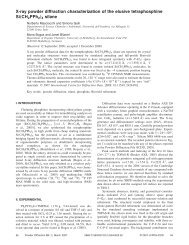
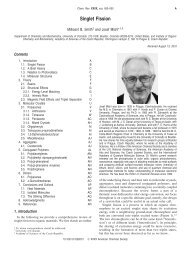
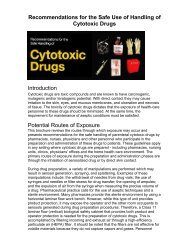
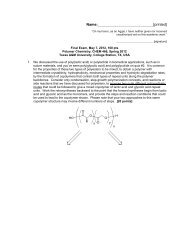

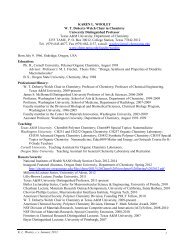
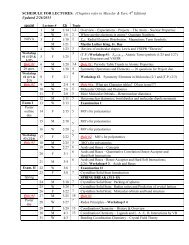
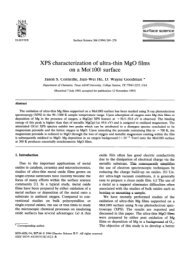
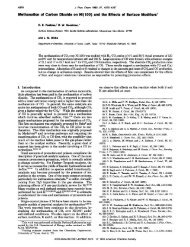
![Radical salts of TTF derivatives with the metal–metal bonded [Re2Cl8]](https://img.yumpu.com/10115211/1/190x253/radical-salts-of-ttf-derivatives-with-the-metal-metal-bonded-re2cl8.jpg?quality=85)


